Wow... I love it! That is absolutely beautiful.
-
You must be a Supporting Member to participate in the Candle Power Forums Marketplace.
You can become a Supporting Member.
You are using an out of date browser. It may not display this or other websites correctly.
You should upgrade or use an alternative browser.
You should upgrade or use an alternative browser.
Learning to lathe [things]
- Thread starter PhotonFanatic
- Start date
 Help Support Candle Power Flashlight Forum
Help Support Candle Power Flashlight Forum
olrac
Flashlight Enthusiast
It's almost hypnotic to look at  oo: , amazing!
oo: , amazing!
PhotonFanatic
Flashlight Enthusiast
There are now a lot of CPF'ers with their own lathes and with the exceptions of those in the business, and one or two lucky individuals, it is safe to say that most of us own manual lathes.
And, I would venture to guess, that the most difficult operation to learn is threading. Sure, there are lots of books and online resources to guide you--to show what the difference is between an ID and an OD, say, or why the lathe cuts right-hand threads when the tool moves toward the headstock. But when it comes time to choose which cutting tool you will use, getting helpful information is a hit or miss proposition. If you are lucky enough to know a machinist, you've just saved yourself a lot of trial and error.
But even if you were to watch a machinist do threading, while you may get the basics down real quick, did you also learn that there are a variety of inserts, or threading bars, that you can pick from? Sure, sure, you know that the toolbit is a 60-degree included angle, you know about side clearance, rake, etc., and you've learned how to set the compound slide to 29 to 29.5 degrees for the starting passes, and how the final cuts should be done with the cross slide being moved into the piece.
But, but -- do you know that there is a threading bit that actually gives one visual signals that you've reached the proper depth of cut?
Tonight I was working on the DG Light, in Ti, after having completed most of the AL prototype. I needed to cut the threads in the bottom of the head and the top of the battery tube, so that the two pieces would mate properly.
Here's the battery tube, which was threaded to accept the head, and in this photo, I'm testing the fit with the previously cut AL head of the DG Light:

And here's a close-up of the threads in the battery tube, showing the O-ring landing and then the threads:

Next, I had to complete the threading on the head. First, though I thought I'd show how I prepare the piece for threading. Here's the piece ready to be threaded:
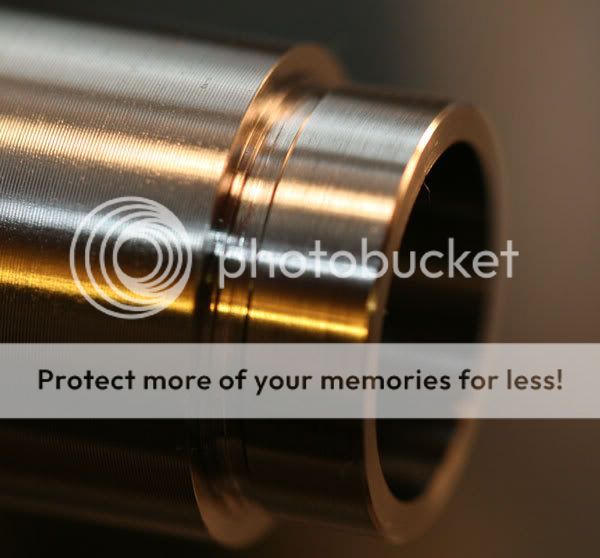
From left to right: The body of the light, with the machining marks clearly showing. Then there is a .5mm flat that will be the visible portion of the battery tube that shows when the twisty is in the off position. By having that flat there, one does not see the ugly black O-ring! Next is the O-ring groove, although it is not to final depth yet--I do that when completing the light. Just to the right of that is the thread relief bevel that I cut for the end of the threads. The reason for doing that is to avoid the ugly burrs that would occur if the threads simply ran into the O-ring groove. Then there is the wide, flat area that is to be threaded, and, finally, the last item to the right is the bevel leading into the threads. That is a 45-degree bevel and seems to work great for getting pieces to thread together seamlessly.
Next is the O-ring groove, although it is not to final depth yet--I do that when completing the light. Just to the right of that is the thread relief bevel that I cut for the end of the threads. The reason for doing that is to avoid the ugly burrs that would occur if the threads simply ran into the O-ring groove. Then there is the wide, flat area that is to be threaded, and, finally, the last item to the right is the bevel leading into the threads. That is a 45-degree bevel and seems to work great for getting pieces to thread together seamlessly.
Well, if you are still with me, you are about to see the magic toolbit that shows you when you have reached the proper depth of cut for your thread pitch. This photo shows the insert, which is traveling from right to left, as it is nearing the end of the preliminary passes/cuts that were made by advancing only the compound slide, set at 29.5 degrees, into the work piece. NOTE CAREFULLY: See the swarf coming off the insert? Notice that it twists to the left:
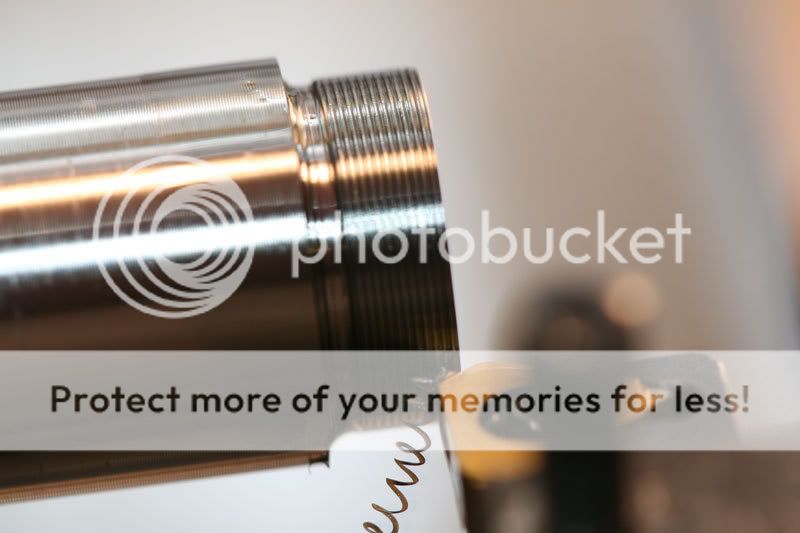
Now why is that, you may ask? Simple enough--the tool is cutting on its left edge only and it is moving from right to left also. So the chip curls off to the left as well.
The final cuts on the work piece, to reach the final depth of cut, is done by advancing the cross slide, which means that the insert will now be entering the work piece perpendicular to the work piece. As a result, the insert will meet the uncut right flank of the V-groove of the thread and cut there primarily, or certainly will cut more metal on that side than on the left side. Now, the next photo is the first cut with the advancement into the piece coming from the cross slide only. NOTE CAREFULLY: The chip is now curling to the right! Bingo! We are very close to the proper depth of cut.
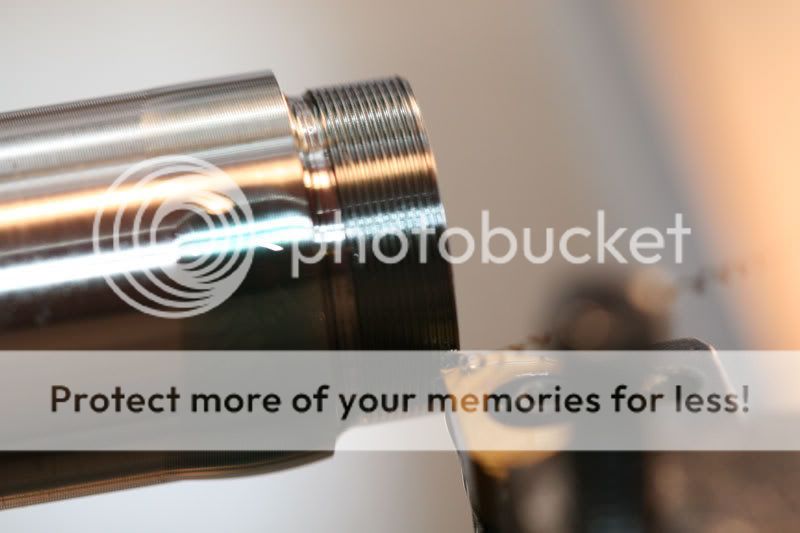
If you now take another cut, a very shallow one, you will be able to see the chip looking more like flakes, than as a curling chip. Time to either stop cutting, or if you have the mate, test fit the pieces together. Like this:
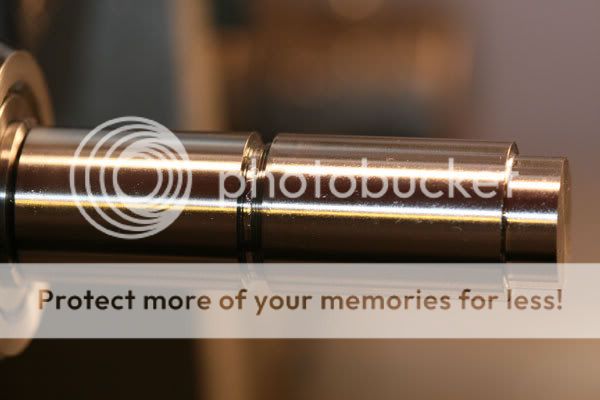
And finally, the end of the road:
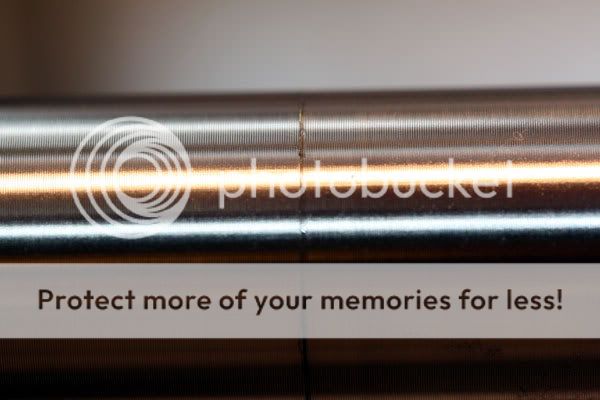
So what are these magic inserts? Well, they are full-form threading inserts--and that basically means that they not only cut the groove to the proper depth, but they also cut the crest of the thread as well. The end result is a very smooth thread, one that does not need to be sanded with anything, not even ScotchBrite!
For those that already knew, all this, and more, I apologize for the lengthy post, but I'm sure that there are some newbies that will find something of use in their forays into the world of cutting threads.
And, I would venture to guess, that the most difficult operation to learn is threading. Sure, there are lots of books and online resources to guide you--to show what the difference is between an ID and an OD, say, or why the lathe cuts right-hand threads when the tool moves toward the headstock. But when it comes time to choose which cutting tool you will use, getting helpful information is a hit or miss proposition. If you are lucky enough to know a machinist, you've just saved yourself a lot of trial and error.
But even if you were to watch a machinist do threading, while you may get the basics down real quick, did you also learn that there are a variety of inserts, or threading bars, that you can pick from? Sure, sure, you know that the toolbit is a 60-degree included angle, you know about side clearance, rake, etc., and you've learned how to set the compound slide to 29 to 29.5 degrees for the starting passes, and how the final cuts should be done with the cross slide being moved into the piece.
But, but -- do you know that there is a threading bit that actually gives one visual signals that you've reached the proper depth of cut?
Tonight I was working on the DG Light, in Ti, after having completed most of the AL prototype. I needed to cut the threads in the bottom of the head and the top of the battery tube, so that the two pieces would mate properly.
Here's the battery tube, which was threaded to accept the head, and in this photo, I'm testing the fit with the previously cut AL head of the DG Light:

And here's a close-up of the threads in the battery tube, showing the O-ring landing and then the threads:

Next, I had to complete the threading on the head. First, though I thought I'd show how I prepare the piece for threading. Here's the piece ready to be threaded:

From left to right: The body of the light, with the machining marks clearly showing. Then there is a .5mm flat that will be the visible portion of the battery tube that shows when the twisty is in the off position. By having that flat there, one does not see the ugly black O-ring!
Well, if you are still with me, you are about to see the magic toolbit that shows you when you have reached the proper depth of cut for your thread pitch. This photo shows the insert, which is traveling from right to left, as it is nearing the end of the preliminary passes/cuts that were made by advancing only the compound slide, set at 29.5 degrees, into the work piece. NOTE CAREFULLY: See the swarf coming off the insert? Notice that it twists to the left:

Now why is that, you may ask? Simple enough--the tool is cutting on its left edge only and it is moving from right to left also. So the chip curls off to the left as well.
The final cuts on the work piece, to reach the final depth of cut, is done by advancing the cross slide, which means that the insert will now be entering the work piece perpendicular to the work piece. As a result, the insert will meet the uncut right flank of the V-groove of the thread and cut there primarily, or certainly will cut more metal on that side than on the left side. Now, the next photo is the first cut with the advancement into the piece coming from the cross slide only. NOTE CAREFULLY: The chip is now curling to the right! Bingo! We are very close to the proper depth of cut.

If you now take another cut, a very shallow one, you will be able to see the chip looking more like flakes, than as a curling chip. Time to either stop cutting, or if you have the mate, test fit the pieces together. Like this:

And finally, the end of the road:

So what are these magic inserts? Well, they are full-form threading inserts--and that basically means that they not only cut the groove to the proper depth, but they also cut the crest of the thread as well. The end result is a very smooth thread, one that does not need to be sanded with anything, not even ScotchBrite!
For those that already knew, all this, and more, I apologize for the lengthy post, but I'm sure that there are some newbies that will find something of use in their forays into the world of cutting threads.
GeorgeMaggos
Newly Enlightened
Hey Fred,
thanks for taking the time to show us just how much work goes into what you make, the photos are great on their own but then to go further & describe what we are seeing makes it all the better.
I appreciate you doing this & sharing it with us :twothumbs
~George
thanks for taking the time to show us just how much work goes into what you make, the photos are great on their own but then to go further & describe what we are seeing makes it all the better.
I appreciate you doing this & sharing it with us :twothumbs
~George
wquiles
Flashaholic
+1 - thanks much for taking the time Fred - much appreciated 
Will
(still learning to lathe things ...)
Will
(still learning to lathe things ...)
PhotonAddict
Enlightened
This is a fantastic thread Fred!
wquiles
Flashaholic
Bump for a great thread, and awesome examples of work in the lathe by Fred 
Will
Will
wquiles
Flashaholic
How do you know how much relief to cut for the o-ring landing, are there any guides?
Welcome to the forums



One of the best guides to O-ring usage is this one:
Parker_O-Ring_Handbook
I would start there first
PhotonFanatic
Flashlight Enthusiast
How do you know how much relief to cut for the o-ring landing, are there any guides?
Will has already directed you to a great resource, but let me chime in to say that my method is to allow for 20% compression for proper sealing and to determine the correct depth of cut for the O-ring groove.
Since I use metric O-rings, with 1mm CS (cross section), that adds 2mm in diameter to whatever groove you place it in. Let's say that the head of a light has an interior diameter of 18mm, where the O-ring will make contact when screwing the head and the battery tube together. Since the O-ring need to be compressed 20%, just take 80% of the 2mm created by the O-ring and subtract than from the 18mm. So 18mm -(2.00CS x80%, or 1.60mm) = 16.40mm--that's the diameter of the O-ring groove that you will need.
Now, just make sure that the bore for battery has a diameter that is well less than 16.40mm, say, around 15mm, or instead of cutting an O-ring groove, you will be performing a parting operation. :devil:
